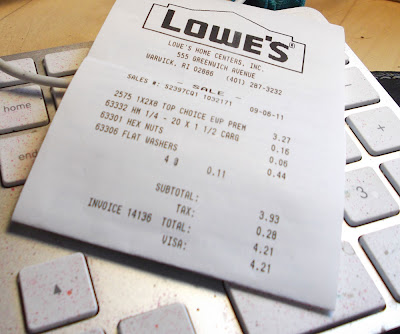Nick has a giant tripod which I'd been using for my videos, which works well, but I really wanted to be able to focus more on the artwork and less on whether or not I had too much cleavage showing. To be honest, I don't want to be in my videos at all! Well, except for my hands... those clearly need to be involved because I have not yet mastered telekinetic art making.
I knew I needed to have some sort of overhead system, but I wasn't quite sure how to make it work.... until I saw a photo of a makeshift set up on Julie Fei-Fan Balzer's blog:
 |
| Photo copyright Julie Fei-Fan Balzer http://balzerdesigns.typepad.com/balzer_designs/2009/07/label.html |
I did a quick sketch of what I thought would work and then Nick helped me figure out the measurements for the camera height and the width of the stand so that it would fit well on my desk. You could obviously customize this to meet your own needs. First, here's a picture of my stand:
My journal pages are 8 x 10, which means the spread is 10 x 16, just to give you a sense of scale. If you were using a smaller journal, you could get away with a smaller camera stand, I bet. If you need a larger area, you'll need a larger stand. In order to figure out the height, I turned my camera on and held it up over the journal until I got just the right view. [I added 1 extra inch, but if I were to make this again, I'd add an extra two or three, just to enable me to zoom in on a single page if I wanted.]
To build one just like mine, you will need:
1 - 1x2x8 pine board cut into the following lengths: 2x20inches, 2x10inches, 1x24inches + remainder scrap*
1 - 1/4 inch x 1.5 inch bolt (#63332) +
1 - 1/4 inch hex nut (#63301)
2 - 1/4 inch flat washers (#63306)
For these items, my grand total came for $4.21 for this project. (And I bought two extra washers.) If you don't already have 8 screws (1.5 inches or so), you'll need to get those, too. I am assuming you already have a power drill. If not, you might want to borrow one from a friend. You could do the screws by hand, but you will need to be able to drill a 1/4 inch hole in the frame for the bolt.
* I bought my board at Lowe's. They will cut your board for you. The signs always say that you get the first two cuts for free & additional cuts are 25 cents each, but no one has ever charged me extra, no matter how many cuts I've gotten. I do recommend going at a slower time of the day, if at all possible, so you won't have to wait in line.
+ Nick says not to buy galvanized because it's poison. Take your camera with you to test out the bolt to make sure it fits. I'm pretty sure all cameras are going to be pretty standard when it comes to tripod stands, but just in case.
The two 10 inch pieces will be the base of your stand. The two 20 inches pieces are the sides. You want to line up the base pieces so that you'll be screwing through the shorter one inch sides. Attach both bases to the sides using two screws on each then side aside.
Look on the base of your camera to see where the tripod attachment is located. Mine is about 1 inch to the left of the center. Find the center of the 24 inch board then adjust according to the tripod base. Doing this ensures that your camera, when attached, will be positioned in the center. (I.e. for my camera, I'll move the measurement 1 inch left before drilling.
Drill a 1/4 inch hole at the mark you made in the last step. You will drill the whole way through the 1-inch wide part (i.e. in the middle of the 2-inch wide part). Use the scrap piece of wood from the 1x2x8 to protect your work surface.
Screw the bolt into the hole you just drilled. Add the two washers then tighten with the nut.
Take this piece and position it between the two sides you already created. Use two screws on each side to attach this longer piece at the top of the sides. (Note that it doesn't matter which way the bolt faces at this point.)
Once your entire stand is screwed together, position it on your work surface so that the part of the bolt that you will be attaching your camera to faces away from you. Screw your camera into place and make any adjustments as needed. I found that my camera would occasionally slide down, no matter how tight I screwed it in initially, so I use a big push pin to hold it up. My camera is very light weight and this works very well for me. If your camera is heavier, you may need to putter a bit to make the stand work for you.
Here's what my camera sees from its new position on the finished camera stand. Sweet, right?










Whew! That's quite a construction project! You guys did a great job. I'm glad you were able to figure out something that addressed your need...have fun with it!!
ReplyDeleteBrilliant! Glad I found your instructions. I always just fly into a project figuring things out as I go. There is usually something that I wish I had done differently in hindsight! Thanks for all the great pics of the process.
ReplyDeleteYa got a new follower!